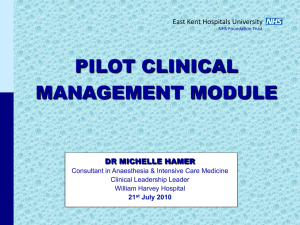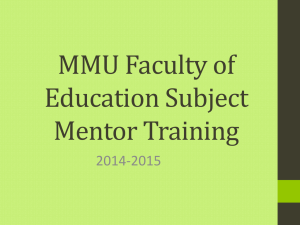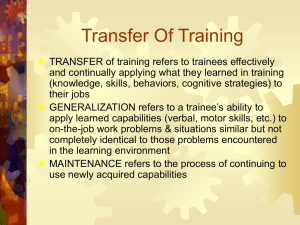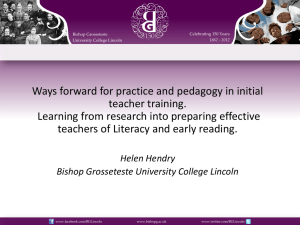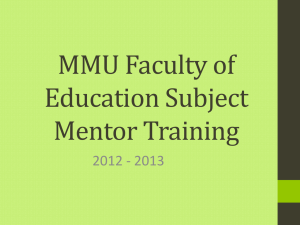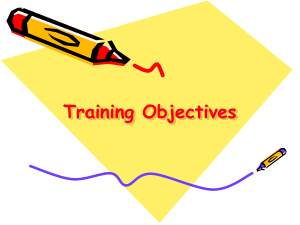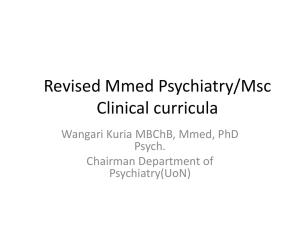The initial assessment of competency
advertisement
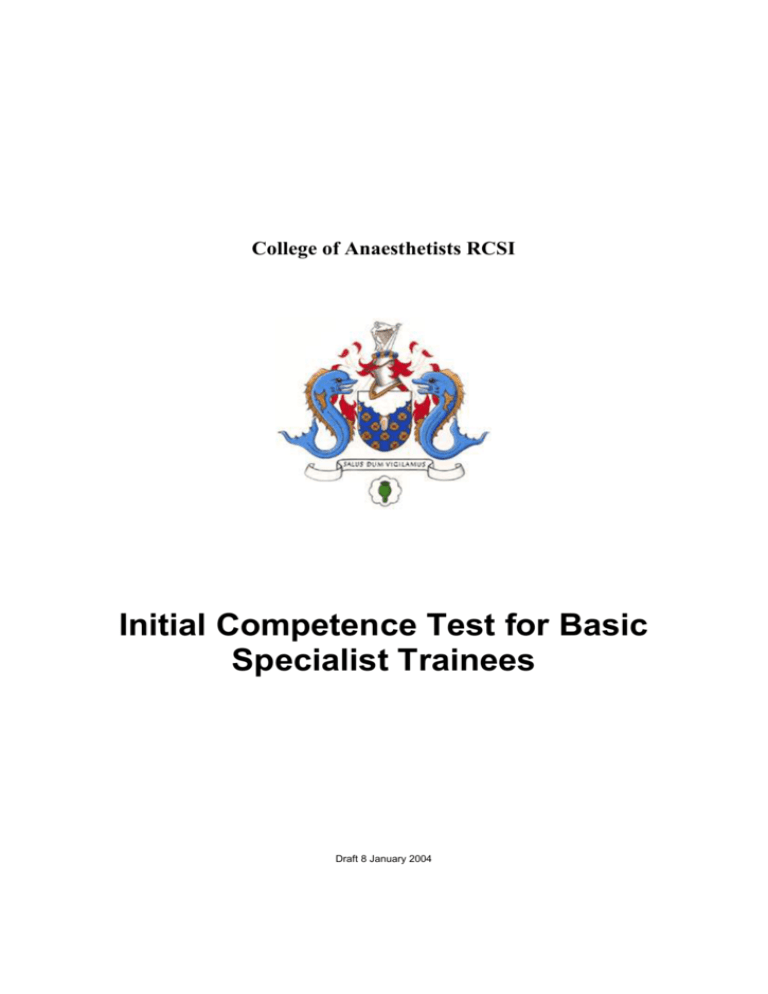
College of Anaesthetists RCSI Initial Competence Test for Basic Specialist Trainees Draft 8 January 2004 Initial assessment of competence Before being permitted to practice anaesthesia without immediate supervision, all trainees must achieve a satisfactory standard in an assessment of competency involving at least two consultant anaesthetists who meet the criteria to be trainers. This applies to both new trainees and to more experienced trainees working in the Ireland for the first time. This initial assessment is designed to demonstrate the possession of basic key components of clinical skill, knowledge and other attributes necessary to progress in the specialty. Until this assessment is completed successfully, no trainee should deliver anaesthesia without immediate supervision either during daytime or ‘out-ofhours’. It is intended that this assessment should be completed by a typical trainee after approximately 3 months of full-time training in anaesthesia, but the exact timing will need to be determined on an individual basis. More experienced trainees who are working in Ireland for the first time, whatever their grade, could be assessed much earlier than 3 months, after a relatively short period of familiarisation. The trainee will be assessed in the following areas: i) Preoperative assessment. ii) General anaesthesia for ASA I or II patients (including equipment and anaesthetic machine check.) iii) Rapid sequence induction. iv) CPR skills. v) Clinical judgement, attitudes and behaviour The skills, knowledge and attitudes expected and the assessment details are given below. The patients seen by trainees will need to be selected so as to be appropriate to the trainees' limited exposure within the specialty and should always be of ASA I or II. Assessments will be formal. Both the assessment and its outcome must be recorded in departmental records and in the trainee’s personal record. Should a trainee be assessed as unsatisfactory in any area, and thus be referred for further closely supervised training, the reasons for this referral must be recorded. The names of assessors must be legible, as must any additional comments. Following the assessment: If satisfactory; trainees may begin to undertake cases delegated to them, without immediate supervision and may be given increased clinical responsibility (for example by working on the ‘on-call’ rota with local or distant supervision.) If unsatisfactory: trainees will need targeted instruction and a re-test. Whether the whole assessment is to be repeated, or targeted at deficient areas is a decision to be taken locally, with regard to local circumstances, and is left to the discretion of the assessors. Details of the Initial Test of Competence and its method of assessment This test is in 5 parts; i) ii) iii) iv) v) Preoperative assessment General anaesthesia for ASA I or II patients (including equipment and anaesthetic machine checks) Rapid sequence induction CPR skills Clinical judgement, attitudes and behaviour If a trainee has successfully completed an ALS course within the last 12 months, (iv) can be omitted Only after this test has been satisfactorily completed can a trainee progress beyond immediate supervision. Each of the 5 parts of the test (i – v, above) can be assessed by one (or more) trainers, but not all 5 parts can be “signed off” by the same single trainer. At least two trainers must be involved in the overall assessment. i) Pre-operative assessment Clinical skills 1. 2. 3. 4. 5. 6. 7. Is able to demonstrate satisfactory communication with staff and patients. Is able, in a manner appropriate to the patient, to take a relevant history, explain the necessary aspects of anaesthesia, and answer their questions. Is able to assess the airway Is able to recognise potential problems requiring senior help Is able to explain the management of post-operative pain and symptom control in a manner appropriate to the patient Is able to interpret basic investigations (FBC, U & Es, chest x ray, ECG) Is able to choose and prescribe an appropriate pre-medication. Knowledge 1. 2. 3. 4. The ASA scale of fitness. The relevance of common inter-current diseases to anaesthesia and surgery. Consent for anaesthesia. Predictors of difficult intubation Setting Patients: All appropriate patients aged 16 and over. Assessments: A ward based demonstration of practical skills. Simultaneous oral confirmation of understanding. Guidance: This is a preliminary test to ensure that the trainee communicates adequately and understands the broad outline of anaesthetic assessment. After three months of training the trainee should be expected to identify patients who are low risk from the anaesthetist’s point of view. There is no expectation of the trainee being able to determine the fitness of patients for operation who are severely ill or who have inter-current disease. The expectation is that they will know which cases to refer to or discuss with senior colleagues. The trainee should have an understanding of whatever premedication he or she intends to use. Assessment of the Pre-operative Visit The trainee must be accompanied on a pre-operative round of patients. Name of trainee……………………………… The Trainee: Yes No Communicates in a satisfactory manner with patients Obtains relevant history Undertakes any physical examination (if indicated) Assesses the airway Understands the pre-operative investigations Explains anaesthesia clearly Discusses pain and explains post operative analgesia clearly Prescribes pre-operative medication as needed Understands the ASA classification Understands consent for anaesthesia and operation This assessment was completed satisfactorily IF NO, GIVE REASONS: Signed ………………………….. Print name……………….. Date ……….. Signed: …………………………. Print name ……………….. Date………… ii): Administration of a safe general anaesthetic to an ASA I or II patient. Clinical skills 1. Explanation of the anaesthetic procedure(s) and surgery to the patient. 2. Appropriate Choice of anaesthetic technique. 3. Pre-use equipment checks 4. Proper placement of I.V. cannula. 5. Attachment of monitoring (including ECG) before induction of anaesthesia 6. Measures blood pressure non-invasively 7. Pre-oxygenation. 8. Satisfactory induction technique. 9. Appropriate management of the airway. 10. Maintenance of anaesthesia, including analgesia. 11. Appropriate perioperative monitoring and its interpretation 12. Recognition and immediate management of any adverse events which might occur 13. Proper measures during emergence from general anaesthesia. 14. Satisfactory hand over to recovery staff. 15. Accurate completion of anaesthetic and other records. 16. Prescription of appropriate post-operative analgesia and anti-emetics 17. Choice of post operative oxygen therapy. 18. Instructions for continued I.V. therapies (if relevant). Knowledge 1. The effects of anaesthetic induction on cardiac and respiratory function 2. The rationale for pre-oxygenation. 3. Methods available for the detection of misplaced ET tubes, including capnography 4. Common causes of arterial desaturation (cyanosis) occurring during induction, maintenance and recovery 5. Common causes and management of intra-operative hypertension and hypotension 6. The immediate management only of cyanosis, apnoea, inability to ventilate, aspiration, bronchospasm, anaphylaxis and malignant hyperpyrexia 7. Trainees must demonstrate an adequate, basic, practical knowledge of anaesthetic pharmacology to support their practice, for example, know about: 2 induction agents, 2 volatile agents, 2 opioids, suxamethonium and 1 competitive relaxant. Setting Patients: ASA I and II patients age 16 years and over requiring uncomplicated surgery in the supine position e.g. hernia, varicose veins, hysterectomy, arthroscopy. Location: Operating theatre. Situations: Supervised theatre practice. Assessments A theatre based demonstration of practical skills. Simultaneous oral case discussion of understanding. Guidance The trainee should be observed undertaking a number of cases using facemask and airway, and/or laryngeal mask and/or endotracheal tube. Care should be taken to ensure that the trainee is skilled in use of bag and mask and does not always rely on the laryngeal mask. The assessor should let the trainee proceed largely without interference and note problems of technique. This should be combined with a question and answer session covering the underlying comprehension of the trainee. The level of knowledge expected is that of a trainee who has been working in anaesthesia for 3 months and should be sufficient to support the specified clinical skills. Exclusions are specialised surgery, rapid sequence induction and children under the age of 16 years. Assessment of ability to administer a general anaesthetic to an elective ASA I or II patient. Name of trainee ………………………….. (a) General anaesthesia with spontaneous respiration The Trainee: Yes No Properly prepares the anaesthetic room and/or operating theatre Satisfactorily conducts a pre-operative equipment check (including the anaesthetic machine and breathing system) Has properly prepared and assessed the patient for surgery Chooses an appropriate anaesthetic technique Establishes IV access Establishes ECG and pulse oximetry Measures the patient’s blood pressure prior to induction Pre-oxygenates as necessary Induces anaesthesia satisfactorily Manages airway competently I) Face mask (+/-) airway II) LMA Makes satisfactory transfer to operating theatre (if applicable) Positions patient safely Maintains and monitors anaesthesia satisfactorily Conducts emergence and recovery safely Keeps an appropriate and legible anaesthetic record Prescribes analgesia appropriately Properly supervises discharge of patient from recovery Understands the need for oxygen therapy This assessment was completed satisfactorily IF NO, GIVE REASONS: Signed …………………… Print name……………………… Date………… Signed ............................ Print name……………………… Date …......... (b) General anaesthesia with endotracheal intubation. Name of trainee……………………….. In addition to the above, the trainee must demonstrate the following: Yes No Assesses the airway properly Knowledge of factors which may make intubation difficult Satisfactory use of laryngoscope Correct placement of endotracheal tube* Demonstrates position of endotracheal tube by (i) observation (ii) auscultation (iii) capnography This assessment was completed satisfactorily IF NO, GIVE REASONS: Signed……………………… Print name……………………… Date………… Signed……………………… Print name……………………… Date………… *If intubation is not possible, the trainee should maintain the airway and allow the assessor to intubate the patient. iii) Rapid Sequence Induction for an ASA I or II patient. Clinical skills 1. Detection of risk factors relating to slow gastric emptying, regurgitation and aspiration. 2. Use of drugs (antacids, H2 receptor antagonists etc) in the management of the patient at risk of aspiration 3. Explanation of pre-oxygenation to the patient 4. Proper explanation of rapid sequence induction (RSI) to patient. 5. Proper demonstration of cricoid pressure to the patient and assistant. 6. Demonstration of the use of: a) tipping trolley b) suction c) oxygen flush 7. Appropriate choice of induction and relaxant drugs. 8. Attachment of ECG, pulse oximeter and measurement of BP before induction. 9. Pre-oxygenation. 10. Satisfactory rapid sequence induction technique. 11. Demonstration of proper measures to minimise aspiration risk during emergence from anaesthesia. Knowledge 1. Risk factors causing regurgitation and aspiration. 2. Factors influencing gastric emptying, especially trauma and opioids. 3. Fasting periods in relation to urgency of surgery 4. Reduction of the risks of regurgitation. 5. Failed intubation drill, emergency airways 6. The emergency treatment of aspiration of gastric contents 7. Basic pharmacology of suxamethonium and repeated doses. Setting Patients: Starved ASA I and II patients aged 16 and over having uncomplicated elective or urgent surgery with normal upper airway anatomy. Location: Operating theatre. Situations: Supervised theatre practice. Assessments A theatre based demonstration of practical skills. Simultaneous oral test of understanding. Guidance This test should ensure competent management of the airway during straightforward urgent surgery. The test must be done on a patient who is adequately starved prior to induction of anaesthesia. The patient may, or may not be, an urgent case. The trainee should be able to discuss methods of prediction of the difficult airway and of difficult intubation. They should be able to explain the failed intubation drill, and the immediate management of the patient that aspirates gastric contents. Assessment of Rapid Sequence Induction Name of trainee………………………. The Trainee must demonstrate: Yes No Preparation of the anaesthetic room and operating theatre Satisfactorily checking of the anaesthetic machine, sucker etc. Preparation of the patient (information and positioning) An understanding of the mandatory periods for pre-operative fasting An understanding of the indications for RSI An adequate explanation of RSI to the patient, including cricoid pressure To the assistant how to apply cricoid pressure Proper pre-oxygenation of the patient The undertaking of a RSI Correct placement of tracheal tube This assessment was completed satisfactorily IF NO, GIVE REASONS: Signed……………………………Print name…………………………..Date…………. Signed……………………………Print name…………………………..Date…………. iv) Cardio-pulmonary resuscitation (CPR). Clinical skills 1. Able to recognise cardiac and respiratory arrest 2. Able to perform cardiac compression. 3. Able to manage the airway during cardiopulmonary resuscitation (CPR): using expired air breathing, bag and mask, laryngeal mask and endotracheal intubation. 4. Able to perform CPR either single-handed or as a member of a team. 5. Able to use the defibrillator. 6. Able to interpret arrhythmias causing and associated with cardiac arrest 7. To perform resuscitation sequences for ventricular tachycardia, VF, asystole, EMD. 8. Able to move a patient into the recovery position Knowledge 1. Resuscitation guidelines 2. The factors relating to brain injury at cardiac arrest. 3. Factors influencing the effectiveness of cardiac compression. 4. Drugs used during CPR (adrenaline (epinephrine), atropine, lignocaine, calcium, magnesium, sodium bicarbonate etc). 5. The ethics of CPR: who might benefit. 6. Record keeping at CPR. Setting Simulated scenario of collapse requiring cardio-pulmonary resuscitation during a practical teaching session Role: Initiate and maintain CPR when necessary. Undertake the role of team leader if no more senior doctor is present, continuing CPR as appropriate, administering necessary drugs and defibrillating if needed. If a more experienced resuscitator is available will adopt an appropriate role in the resuscitation team. Locations: Wherever necessary. Assessments Manikin based practical assessment of CPR skills. Arrhythmia recognition session using monitor. Oral assessment of knowledge of resuscitation. If a trainee has completed an ALS course within the last 12 months, the assessment of CPR competency can be assumed and signed off with a comment made to that effect under the signature(s). Assessment of Cardiopulmonary resuscitation This assessment may be undertaken at any time and may be combined with a practical teaching session. Name of trainee………………………………… The Trainee: Yes No Ensures personal safety and that of the staff Calls for help Demonstrates the diagnostic method Demonstrates mask to mouth rescue breathing. Demonstrates ventilation with mask and bag Demonstrates satisfactory insertion of and ventilation with ET tube Demonstrates satisfactory cardiac compression. Satisfactorily interprets common arrhythmias on ECG monitor. Understands the indications for defibrillation. Demonstrates correct use of defibrillator Understands the use of appropriate drugs during resuscitation Can undertake the lead role in directing CPR. Demonstrates moving a patient into the recovery position This assessment was completed satisfactorily IF NO, GIVE REASONS Signed…………………………Print name…………………………Date……………… Signed…………………………Print name…………………………Date……………… If a trainee has completed an ALS course within the last 12 months, the assessment of CPR competency can be assumed and signed with a comment made to that effect under the signature(s). v): Clinical judgement, attitudes and behaviour At this early stage in a trainee's career all that is required is confirmation of the statement on the assessment sheet below. Assessment of clinical judgement, attitudes and behaviour Name of trainee ________________ To the best of my knowledge and belief this trainee has 1. Shown care and respect for patients 2. Demonstrated a willingness to learn 3. Asked for help appropriately 4. Appeared reliable and trustworthy Signed…………………………….Print name………………………Date……………. Signed…………………………….Print name……………………….Date……………
